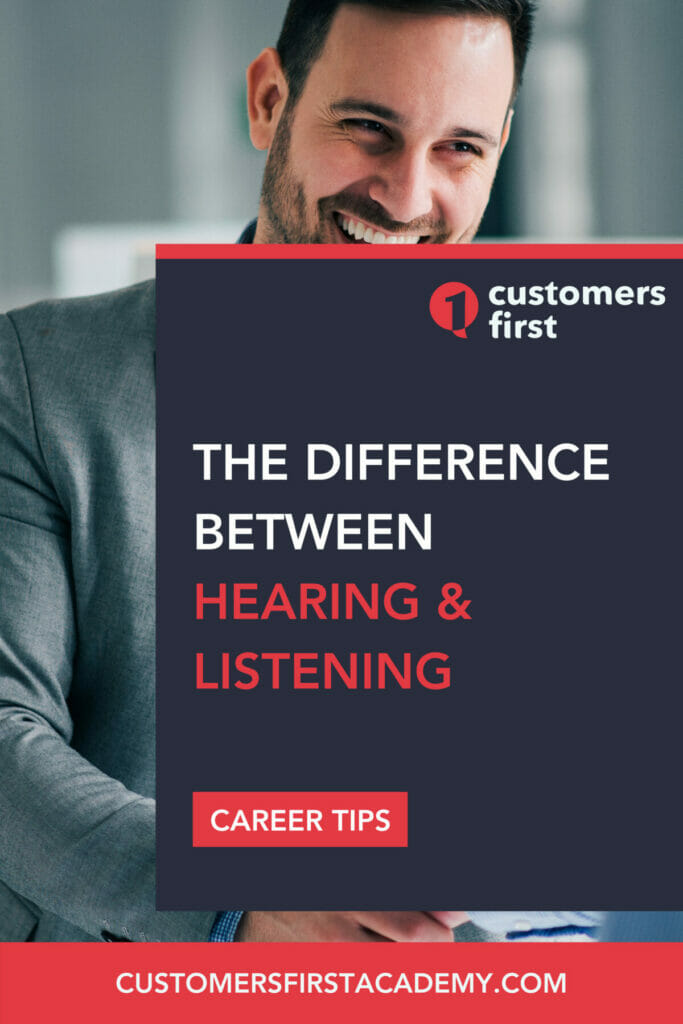What’s the Difference Between Hearing and Listening?
While we tend to use the terms interchangeably, there’s actually a big difference between hearing and listening. Learning techniques like active listening can have enormous benefits for customer service professionals – both inside and outside of the work environment. In this post, we’ll take a closer look at the difference between hearing and listening and learn how to be active listeners!

Definitions of Hearing and Listening
Firstly, let’s see what the official definitions of these terms look like thanks to the Merriam-Webster dictionary:
Hearing means:
“the process, function, or power of perceiving sound; specifically: the special sense by which noises and tones are received as stimuli.”
Listening means:
“to pay attention to sound; to hear something with thoughtful attention; and to give consideration.”
As you can see, hearing is a purely physical process, while listening is also a mental or cognitive process.
The Differences Between Hearing and Listening
The biggest difference between hearing and listening is that hearing is a passive process, while listening requires the person to actively pay attention. Hearing doesn’t require any concentration or effort, whereas listening does.
Hearing is also involuntary – you don’t have any choice whether you do or don’t hear something. Listening is voluntary – you must make an effort and choose to really understand and process what is being said to you.

Listening is also a crucial differentiator between whether you do or don’t learn something. Everyone has had the experience of coming away from a class or lecture you found boring and feeling like you don’t remember a single word of what was said. You might have heard the teacher speaking, but you weren’t listening enough to consciously retain any information.
The Benefits of Active Listening in Customer Service
In order to assist any customer, you first need to understand their problem and their concerns – and that starts with listening to what they have to say. Active listening, which we’ll discuss in detail next, takes this one step further.
Here are some of the benefits you’ll experience as a customer service agent if you start practicing this valuable skill:
- You’ll be able to develop a deeper connection and build a better rapport with the customer.
- You’ll be better able to identify and solve problems.
- You won’t miss crucial information that can help you resolve the customer’s issue.
- You’ll avoid misunderstandings that could escalate the problem.
- You’ll learn a lot! Both in your professional and personal life, active listening lets you identify (and retain) useful details, facts, and information you might otherwise never have picked up on.
- Active listening helps create trust. When the customer knows you’re paying attention, they also know they’re being taken seriously.
This is another big difference between hearing and listening – really listening comes with a whole array of advantages that simply hearing doesn’t.

How to Be an Active Listener
Convinced? Here’s how to master the skill of active listening!
- Use short affirmations to let the customer know you’re paying attention.
Many people start to feel uncomfortable speaking for a long period of time if what they’re saying isn’t being acknowledged. Short verbal affirmations are a great way to let them know you’re listening without actually interrupting them.
They encourage the customer to keep talking, so you have a chance to pick up on small details as well as their emotions on the subject. Some simple affirmations include:
- “I see”
- “I agree”
- “That makes sense”
- “Yes, I understand.”
If the customer trails off or hesitates, a simple, “Please continue” or “I’m listening” are also useful.
- Paraphrase what the customer says
Repeating the customer’s problem in your own words is a good way of establishing whether you’ve understood correctly. This technique can also be helpful if the customer’s query has been a little vague or confusing.
For example, “So just to make sure I understand, you feel the product you received didn’t look like what you saw on the website?”
- Use empathy statements
Demonstrating empathy is an excellent active listening technique to use, especially in customer service, as it helps the customer feel they can trust you. This makes them more willing to divulge detailed information and open up about how the issue has made them feel.
Some good empathy statements include:
“I’m sorry you’ve had to deal with this.”
“I really understand your frustration.”
“I’d feel exactly the same way in your position.”
“You’re 100% right to feel that way.”
“I really appreciate you taking the time to bring this to my attention.”
- Eliminate distractions
Do everything you can to focus solely on what the customer is saying. It’s hard to pay attention when there are other things pulling your focus away. For example, close all unnecessary tabs or programs on your computer, choose as quiet a spot as possible, and make sure your phone is out of sight.
- Ask open-ended and probing questions
Open-ended questions can’t be answered with a yes or no, so they force the customer to give you more details.

For instance, “I can see how that would be frustrating for you. What impact did this have on your business?”
Probing questions take information the customer has already given you, and prompt them to go into greater detail.
For example, “Thank you for sharing your concern about adding new users to the platform with me. Could you describe how you’d like the process to work ideally?”
Here’s a helpful audio tutorial covering 20+ probing questions you can ask your customers!
- Defer judgment
Perhaps the most important active listening skill of all is never to assume that you know what the customer will say or understand exactly what their problem is. Always give them the time and the space to have their say and reserve making judgment until you’ve heard the whole story, without interrupting them.
- Practice makes perfect
Remember that active listening is a skill that takes time to polish. The good news is that once you’ve made it a habit, it becomes effortless! Keep practicing, and you (and your customers!) will soon be enjoying all those benefits we discussed.

Improve your listening skills and transform the way you communicate with customers!
Other Resources:
CustomersFirst Academy offers comprehensive customer service training designed to help you grow your skills and advance your career.
To keep learning and developing your knowledge of customer service, we highly recommend the additional resources below:
Consumer vs Customer: Is There a Difference?
Customer Service Synonyms
Learn How to Address Multiple People in an Email
Customer’s or Customers’?

